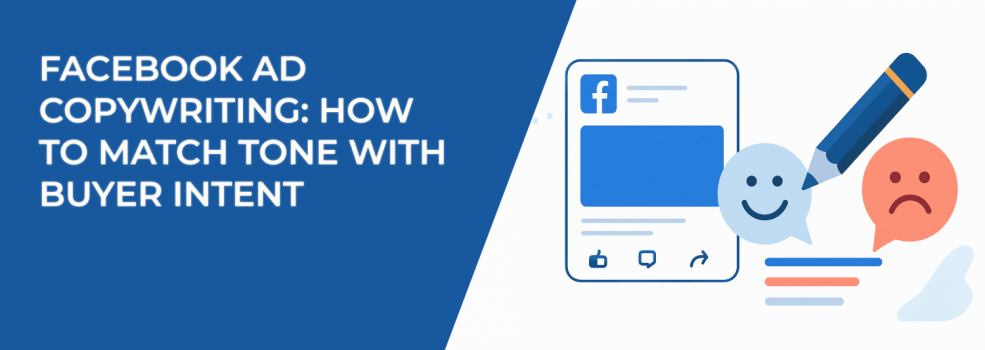You can have sharp targeting and impressive visuals — but if the tone of your ad copy doesn’t match the buyer’s intent, your campaign is likely to underperform.
While many marketers focus on audience selection and creative elements, the way you communicate is equally important. Your tone sets the emotional temperature of the message. If it feels off — too pushy, too casual, too vague — the reader will scroll past, regardless of how strong your offer is.
Facebook ad copy should meet the reader where they are — in their mindset, awareness, and decision-making process. This article will guide you through how to tailor tone at each stage of buyer intent, and give you the tools to write ad copy that feels relevant, compelling, and timely.
Let’s dive into how to write smarter, more context-aware Facebook ads — with practical examples and structure tips throughout.
Why Matching Tone to Intent Matters
Tone is not an afterthought. It plays a central role in how your message is received — especially in environments like Facebook and Instagram, where users aren’t actively searching for solutions.
When someone sees your ad in their feed, they subconsciously ask:
-
Does this feel relevant to me right now?
-
Can I trust this brand or message?
-
Is this worth clicking on or exploring further?
If your tone answers those questions in a way that aligns with where the user is in their buyer journey, your chances of engagement go up. If it doesn’t — even a well-crafted offer or beautifully designed creative won’t save the ad.
So how do you adjust tone based on intent?
Understanding Buyer Intent: The Three Levels
Before writing any ad copy, clarify who you're speaking to and what they might be thinking or feeling at that moment.
Most audiences can be categorized into three core levels of intent:
1. Low Intent
This audience is cold — they’ve likely never heard of your brand. They’re not actively looking for a solution and might not even be aware they have a problem. Your goal here isn’t to convert, it’s to connect.
2. Mid Intent
These are warm prospects. They’re aware of the problem, and may have explored similar products or services. They’re open to solutions, but they need context, proof, and a bit of direction.
3. High Intent
These users are ready to act. They’ve done some research, maybe visited your site, and are in the decision phase. They don’t need a backstory — they need clarity and confidence.
Each of these stages requires a different tone, focus, and CTA strategy.Before writing any ad copy, clarify who you're speaking to and what they might be thinking or feeling at that moment. If you haven’t clearly defined your target segments yet, this guide can help you break that down step by step.
Writing for Low Intent: Focus on Curiosity, Awareness, and Light Engagement
When targeting a low-intent audience, your main objective is to start the conversation. These users are not looking to buy — they’re scrolling casually, possibly unaware of your brand or their underlying problem.
The tone here should be light, approachable, and a little curious. You want to spark interest, not overwhelm or push for a sale too early.
Use this tone to:
-
Create awareness of a challenge or gap they didn’t know they had,
-
Gently introduce a new perspective or insight, and
-
Encourage interaction without requiring a strong commitment.
Examples of effective low-intent ad copy:
-
“Ever wondered why your Facebook ads are getting clicks — but no actual results?”
-
“There’s one setting most advertisers overlook. Could it be draining your budget?”
-
“You don’t need more budget. You need smarter segmentation.”
-
“What if your targeting is actually too broad — and that's what’s slowing growth?”
These examples work because they don’t sell — they open a mental loop. They invite the reader to stop and think, “Maybe this applies to me.”
Helpful structure for low-intent copy:
-
Start with a question or surprising insight.
-
Mention a relatable situation or mistake.
-
End with a light CTA — such as “See how it works” or “Find out what to check.”
Keep it soft. The goal is to start the funnel — not close it.
Writing for Mid Intent: Guide the Reader with Clarity and Practical Value
With mid-intent users, you're dealing with people who know they have a problem. They’ve tried things. They might be actively searching for a better solution.
Here, your tone should be supportive, credible, and clearly solution-oriented. You’re still building trust, but the conversation can shift from “here’s what’s wrong” to “here’s what you can do.”
Use this tone to:
-
Offer insights that help them feel more informed,
-
Build confidence in your solution with subtle proof, and
-
Clarify why your approach is different — or more effective.
Examples of mid-intent ad copy:
-
“We helped a retail brand cut Facebook lead costs by 42% — without touching the creative.”
-
“Still stuck in the learning phase? Here’s what might be causing it — and how to fix it.”
-
“If your cost-per-result keeps climbing, it might be your audience structure — not your ads.”
-
“Why most advertisers skip testing lookalike layers — and how to use them for faster conversions.”
These lines speak to someone who’s been in the game — and is ready for something that actually works.
Effective structure for mid-intent copy:
-
Begin with a challenge or pain point.
-
Present a result, insight, or specific example.
-
Add light proof (e.g., percentage, use case, quote), then invite action.
You’re still nurturing, but with more authority. Mid-intent audiences are looking for validation — and options. Give them both.
Writing for High Intent: Lead with Authority and Eliminate Friction
High-intent prospects don’t need the full story — they need answers. They’ve likely compared vendors, read reviews, maybe even interacted with your content.
Your tone here should be direct, confident, and benefit-driven. Focus on ease, speed, ROI, and proof.
Use this tone to:
-
Reinforce that the reader is making a smart choice,
-
Reduce doubts or decision friction, and
-
Motivate immediate action with a compelling CTA.
Not sure how to spot users with high buying intent? This article covers how to identify high-intent audiences using Facebook Insights, so you can better tailor your copy to match.
Examples of high-intent ad copy:
-
“Launch smarter Facebook campaigns in under 10 minutes — no learning curve, no wasted spend.”
-
“Used by 3,000+ advertisers to reduce CPA by up to 35%. See the results for yourself.”
-
“Start your 7-day free trial. No credit card. No risk. Just results.”
-
“Powerful audience targeting built for marketers who don’t have time to guess.”
These examples assume the reader is serious — and want a fast, confident path forward.
Ideal structure for high-intent copy:
-
Start with the outcome — what they’ll gain.
-
Support it with quick proof or metrics.
-
Use a strong, direct CTA (“Start trial,” “Get instant access,” “See how it works”).
At this stage, clarity and confidence outperform cleverness. Don’t overcomplicate. Just show them why you’re the right choice — now.
Common Tone Mistakes That Undermine Ad Performance
Even strong campaigns can fail if the tone is off. Here are four mistakes advertisers often make when tone doesn’t match buyer intent:
1. Using urgency on cold traffic.
Saying “Last chance!” to someone who’s never heard of you feels pushy and unnatural. Low-intent users need a reason to care — not pressure to act.
2. Overexplaining to high-intent users.
When someone’s ready to buy, they don’t need a lesson — they need reassurance and action steps. Get to the point.
3. Writing in the same tone for every campaign.
One-size-fits-all copy sounds generic — and it performs that way, too. Adjust tone per funnel stage, offer, and awareness level.
4. Mismatching tone and creative.
A sleek, minimalist design with quirky or casual copy sends mixed signals. Make sure tone and visuals reinforce each other.
To catch tone issues early, read your copy out loud — or better yet, test variations side by side. Even slight shifts in voice and structure can dramatically change how your ad is received.
Tone and targeting go hand-in-hand. Even the most well-written copy will underperform if it’s shown to the wrong group. If you're still fine-tuning your targeting approach, check out this foundational guide.
Final Thoughts
It’s easy to overlook tone in favor of more technical elements like budget optimization, targeting, or A/B testing. But tone is what turns a message into momentum.
When your ad tone reflects what the buyer is feeling, it builds trust. It makes your offer feel relevant. It makes your brand feel aligned — not intrusive.
In competitive ad auctions, tone is what sets you apart. It doesn’t require more spend — just more thought.
So if performance is plateauing, check the tone. Not just what you're saying — but how you're saying it, and who you're saying it to.

